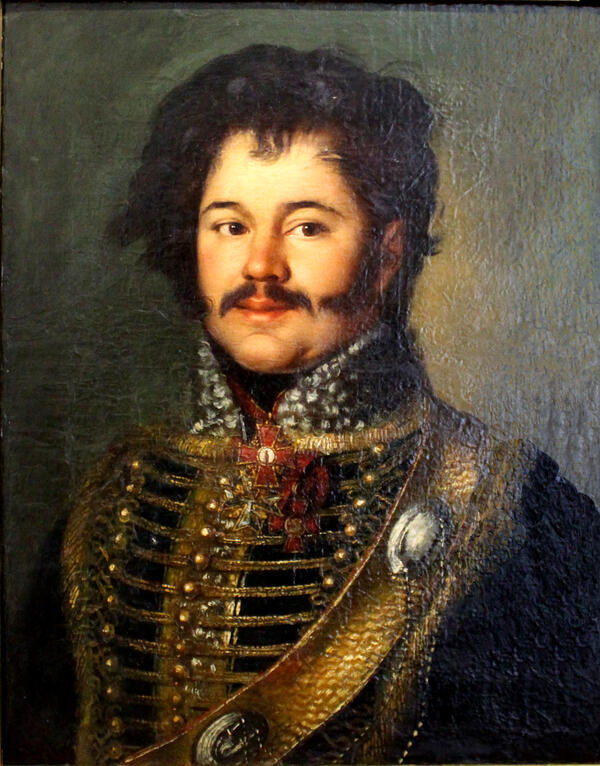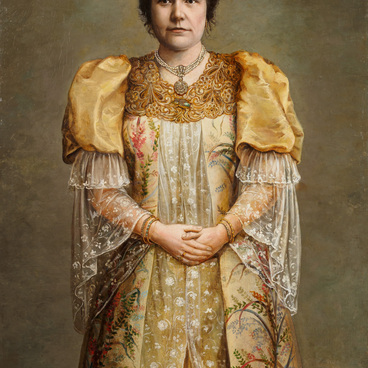This portrait of the hussar Alexey Petrovich Pyatov from the collection of the Uglich Museum originated from the Rodichevo estate on the left bank of the Volga. The village used to belong to the Pyatovs, and later to the Cheremisinovs, the Kalachyovs, and the Cherkasovs. The Pyatovs descended from Fyodor Byakont who had come from Prussia to serve in Russia a long time before. An old painting depicting their venerable ancestor on his way to Russia was displayed in the manor.
The estate itself was founded by Alexandra Mikhailovna Pyatova who married Colonel Cheremisinov. The estate particularly flourished during the time of their descendant Boris Pavlovich Cherkasov in the early 20th century. The house with panoramic windows and dark-oak-finished interiors was built in the style of Swiss chalets. Old 16th- and 17th-century documents used to be stored there as well as a portrait gallery that took pride of place. The house burned down in the 1920s and as a result, a large library was lost. Only part of the estate’s art collection was transferred to the Uglich Museum where it is still kept today.
This is a typical “hussar” portrait. The young man is depicted dressed up in colorful smart clothes. The dolman with gray sheepskin trimming, golden braids, three rows of buttons, and red orders near the collar — all of these attributes of bravery and smartness flatter the young full-blooded man. His eyes are dark and lively, and his abundant hair is combed forward in a romantic hairstyle. It is slightly unkempt, as though some of the wavy strands are blown across his forehead and temples by the wind — all of this indicates the invigoration, fearlessness, and excitement of the young hussar. At the same time, his chubby face is kind, and his plump lips are smiling. He seems to be portrayed in the middle of merrymaking, a festive party with friends, and not in a military camp or before a battle.
Unfortunately, no information about the life of the hussar Pyatov has been discovered so far, and this portrait from the house of his relatives remains a mystery for both museum staff and military historians. This painting is presented in the Uglich portrait gallery as the image of a typical nobleman of the time of wars, victories, and parades.
The estate itself was founded by Alexandra Mikhailovna Pyatova who married Colonel Cheremisinov. The estate particularly flourished during the time of their descendant Boris Pavlovich Cherkasov in the early 20th century. The house with panoramic windows and dark-oak-finished interiors was built in the style of Swiss chalets. Old 16th- and 17th-century documents used to be stored there as well as a portrait gallery that took pride of place. The house burned down in the 1920s and as a result, a large library was lost. Only part of the estate’s art collection was transferred to the Uglich Museum where it is still kept today.
This is a typical “hussar” portrait. The young man is depicted dressed up in colorful smart clothes. The dolman with gray sheepskin trimming, golden braids, three rows of buttons, and red orders near the collar — all of these attributes of bravery and smartness flatter the young full-blooded man. His eyes are dark and lively, and his abundant hair is combed forward in a romantic hairstyle. It is slightly unkempt, as though some of the wavy strands are blown across his forehead and temples by the wind — all of this indicates the invigoration, fearlessness, and excitement of the young hussar. At the same time, his chubby face is kind, and his plump lips are smiling. He seems to be portrayed in the middle of merrymaking, a festive party with friends, and not in a military camp or before a battle.
Unfortunately, no information about the life of the hussar Pyatov has been discovered so far, and this portrait from the house of his relatives remains a mystery for both museum staff and military historians. This painting is presented in the Uglich portrait gallery as the image of a typical nobleman of the time of wars, victories, and parades.



